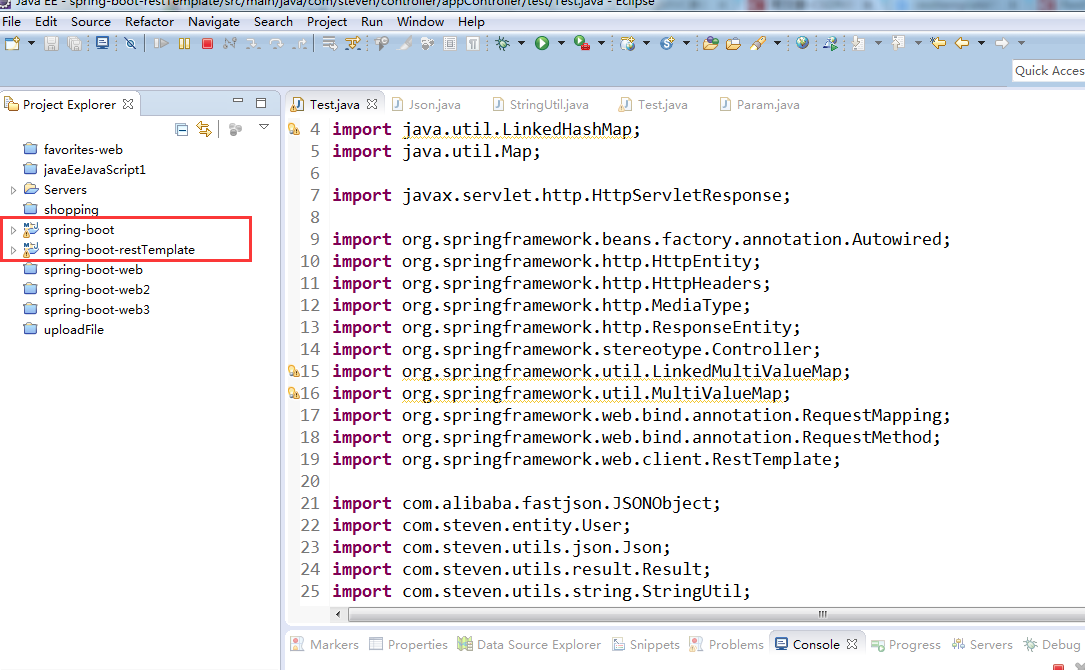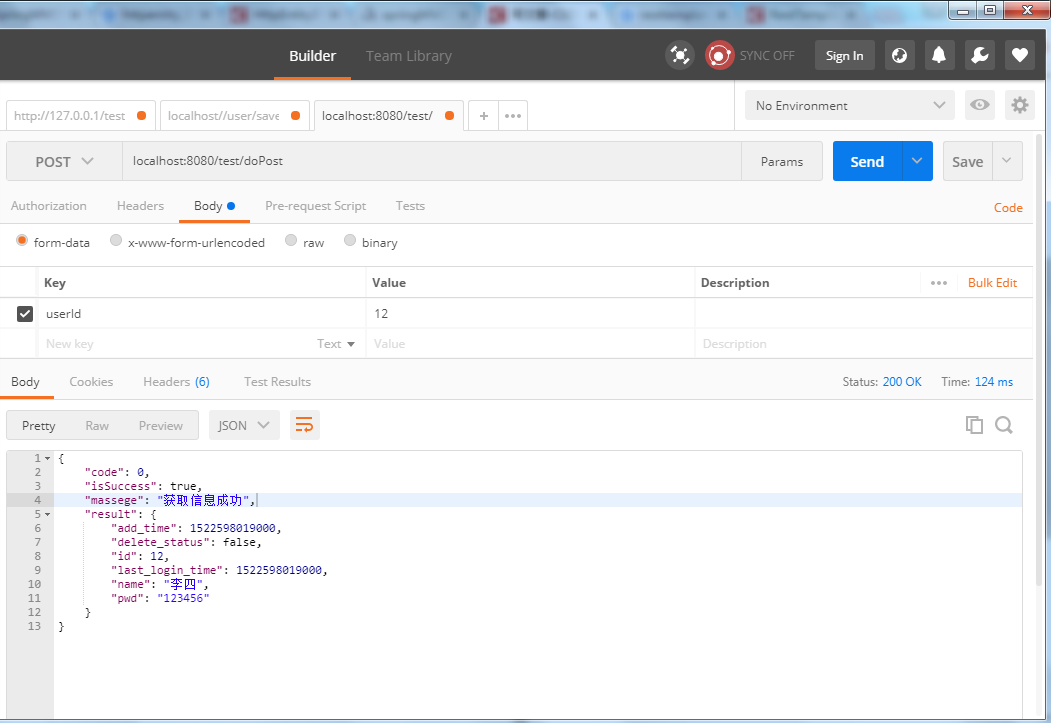我们一般在项目中会遇到某个需求和上一个项目的需求一模一样,那我们就会直接去访问之前项目的接口,不会在另写,或者说调用3方接口。这就用到RestTemplate ,RestTemplate简单的理解就是:简化了发起 HTTP 请求以及处理响应的过程。
自己在本地搭建了两个项目,通过B项目去访问A项目中的接口并处理返回数据;还是老样子,直接看代码。
我首先搭建了两个项目分别是spring-boot和spring-boot-restTemplate;我把spring-boot项目看作三方服务,
然后我在spring-boot项目里面写了一个测试接口来供spring-boot-restTemplate项目调用;因为我们说了是做json的格式传递参数嘛,所以我用了@requestBody,请看下面的代码
package com.steven.controller.appController.test;import javax.servlet.http.HttpServletRequest;
import javax.servlet.http.HttpServletResponse;import org.springframework.beans.factory.annotation.Autowired;
import org.springframework.stereotype.Controller;
import org.springframework.web.bind.annotation.RequestBody;
import org.springframework.web.bind.annotation.RequestMapping;
import org.springframework.web.bind.annotation.RequestMethod;import com.steven.entity.User;
import com.steven.entityVo.param.Param;
import com.steven.service.UserService;
import com.steven.utils.json.Json;
import com.steven.utils.result.Result;@Controller
@RequestMapping(value="/test")
public class Test {@Autowiredprivate UserService userService;/*** 查询用户详细信息* @param response* @param userId*/@RequestMapping(value="/findOne", method=RequestMethod.POST)public void findOne(HttpServletRequest request, HttpServletResponse response, @RequestBody Param param) throws Exception{Integer userId = param.getUserId();User user = userService.findOne(userId);if(user == null){Json.toJson(new Result(false,1,"该用户不存在",null), response);return;}Json.toJson(new Result(true, 0, "获取用户信息成功", user), response);}
}接下来就是重点了,主要讲RestTemplate了,在我们项目中引用RestTemplate 需要注册RestTemplate Bean 也就是说我们要写一个配置文件来配置它。这个也很简单,网上资料一大堆。
package com.steven.config;import org.springframework.context.annotation.Bean;
import org.springframework.context.annotation.Configuration;
import org.springframework.http.client.ClientHttpRequestFactory;
import org.springframework.http.client.SimpleClientHttpRequestFactory;
import org.springframework.web.client.RestTemplate;@Configuration
public class RestTemplateConfig {@Beanpublic RestTemplate restTemplate(ClientHttpRequestFactory factory){return new RestTemplate(factory);}@Beanpublic ClientHttpRequestFactory simpleClientHttpRequestFactory(){SimpleClientHttpRequestFactory factory = new SimpleClientHttpRequestFactory();factory.setReadTimeout(10000);//单位为msfactory.setConnectTimeout(10000);//单位为msreturn factory;}
}再然后就是我们的测试接口了,下面代码主要重点关注一下HttpEntuty对象,它其实就是传参的重点。
package com.steven.controller.appController.test;import java.util.HashMap;
import java.util.Map;import javax.servlet.http.HttpServletResponse;import org.springframework.beans.factory.annotation.Autowired;
import org.springframework.http.HttpEntity;
import org.springframework.http.HttpHeaders;
import org.springframework.http.MediaType;
import org.springframework.http.ResponseEntity;
import org.springframework.stereotype.Controller;
import org.springframework.web.bind.annotation.RequestMapping;
import org.springframework.web.bind.annotation.RequestMethod;
import org.springframework.web.client.RestTemplate;import com.alibaba.fastjson.JSONObject;
import com.steven.entity.User;
import com.steven.utils.json.Json;
import com.steven.utils.result.Result;
import com.steven.utils.string.StringUtil;@Controller
@RequestMapping(value="/test")
public class Test {//调用spring里面RestTemplate需要配置bean@Autowiredprivate RestTemplate restTemplate;/*** post请求远程调用* @param response* @param userId* @throws Exception*/@RequestMapping(value="/doPost", method=RequestMethod.POST)public void doPost(HttpServletResponse response, Integer userId) throws Exception{String url="http://127.0.0.1/test/findOne";HttpHeaders headers = new HttpHeaders();//定义请求参数类型,这里用json所以是MediaType.APPLICATION_JSONheaders.setContentType(MediaType.APPLICATION_JSON);//RestTemplate带参传的时候要用HttpEntity<?>对象传递Map<String, Object> map = new HashMap<String, Object>();map.put("userId", userId);HttpEntity<Map<String, Object>> request = new HttpEntity<Map<String, Object>>(map, headers);ResponseEntity<String> entity = restTemplate.postForEntity(url, request, String.class);//获取3方接口返回的数据通过entity.getBody();它返回的是一个字符串;String body = entity.getBody();//然后把str转换成JSON再通过getJSONObject()方法获取到里面的result对象,因为我想要的数据都在result里面//下面的strToJson只是一个str转JSON的一个共用方法;JSONObject json = StringUtil.strToJson(body);if(json != null){JSONObject user_json = json.getJSONObject("result");//这里考虑 到result也可能为null的情况,因为字符串转json会把字段为null的过滤掉;if(user_json != null && !"{}".equals(user_json.toString())){//调用JSONObject.toJavaObject()把JSON转成java对象最后抛出数据即可User user = JSONObject.toJavaObject(user_json, User.class);//最后抛出json数据Json.toJson(new Result(true, 0, "获取信息成功", user), response);return;}else{Json.toJson(new Result(false, 1, "没有信息", null), response);return;}}else{Json.toJson(new Result(false, 1, "没有信息", null), response);}}}最后看下测试结果测试成功。

